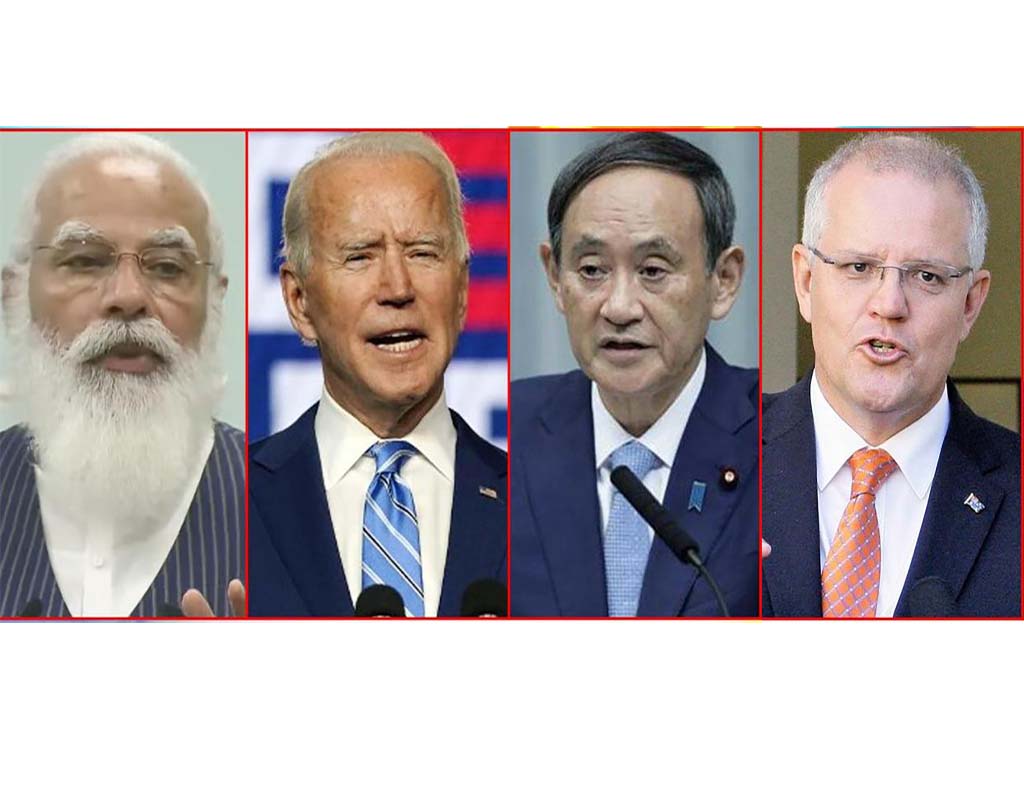
The Big News
Heads of the governments of India, USA, Japan and Australia will be meeting virtually on March 12, Friday, as part of the Quad, better known as the Quadrilateral coalition.
The Agenda
Prime Minister Narendra Modi, President Joe Biden, Prime Minister Yoshihide Suga and Prime Minister Scott Morrison will hold a virtual meeting to "discuss regional and global issues of shared interest, and exchange views on practical areas of cooperation towards maintaining a free, open and inclusive Indo-Pacific region." The elephant in the room here is China, and its aggressive military stance in the Indo-Pacific, which will be the focal point of the dialogue.
An official statement by the Ministry of External Affairs says that the "Summit will provide an opportunity to exchange views on contemporary challenges such as resilient supply chains, emerging and critical technologies, maritime security, and climate change. The Leaders will discuss ongoing efforts to combat Covid-19 pandemic and explore opportunities for collaboration in ensuring safe, equitable and affordable vaccines in the Indo-Pacific region."
Simply put, the Quad agenda has broadened. The sole emphasis is not only security, but other areas, especially developing new supply chains that are not critically reliant on China. The stress on "emerging and critical technologies" also signals that the quartet is likely to work together on advanced areas such as AI, robotics, dornes, advanced materials and aviation among others. This would be an effective counter to Made-in-China 2025–Beijing's blueprint to become a tech superpower.
Why is it Important?
Without saying so explicitly, the statement from the Government of India makes it clear that China's military assertiveness in the Indo-Pacific region will be discussed by the leaders.
What is also clear is that besides the Chinese assertiveness, world trade that suffered due to the break in supply lines caused by the deadly coronavirus pandemic is also part of the agenda. The top gathering will also discuss if those supply chains can be replaced and relocated. The four leaders will also look at enabling countries in the Indo-Pacific region to get vaccines in time to get their economies and health systems back on track. The evolution of the Quad, and whether it develops into a de facto alliance, or take steps in that direction to deter China will be of considerable international interest.
The Genesis of the Quad
The genesis of the Quad lies in the Indian Ocean Tsunami of 2004 – a catastrophic event for many nations in South Asia and South-East Asia where India was one of the severely affected nations. Recognising India's capabilities, the US invited India to be a part of the Tsunami Core Group, along with Japan and Australia.
The group was subsequently expanded to include the UN, EU and Canada.
The post-Tsunami development and relief supplies that India provided as part of the newly-formed Quad was also a ‘coming of age' event for the Indian Navy, wherein it realised that it would need to augument its capacities in numerous ways. Procure large deck amphibious ships, vessels that would carry men and material quickly, the need for helicopters on ships for quick transfers and definitely a vaster maritime reach for India.
Tsunami Core Group Morphs
With the emergency and immediate aid needs taken care off by the grouping, Shinzo Abe, the then Prime Minister of Japan pressed for the formation of a formal grouping – the Quadrilateral Security Dialogue or ‘Quad'. The idea was met with immediate opposition by China, which could see that the grouping could pose a danger to its own ambitions in the not-so-distant future.
Japanese Persuasion, Indian Hesitation
Both Japan and the US have been positive about the role of the grouping, however, India has been reluctant to make it formal and bigger trying to balance Chinese sensitivities about the group.
With the highly conspicuous Chinese aggression in 2020 against its neighbours on many fronts – in the south against India, in the east against Japan and Taiwan and in the South-East against nations like Vietnam, the idea of the Quad as a formal entity began gathering steam. This did not prevent China from making its wolf warrior noises against individual members or the group.
The Malabar 2020 Exercise
In 2020, this four-member group came together for the Malabar maritime exercise in the Bay of Bengal and the Arabian Sea. The Malabar Exercise, which had started as a bilateral exercise between the Indian and US navies in 1992, had participation by Japan in 2015 and by Australia in 2020 – invited just a fortnight ahead of the naval exercise.
The focus for Malabar 2020 was on aircraft carriers – Vikramaditya of the Indian Navy and Nimitz of the US Navy. These two battleships were joined by destroyers, frigates, submarines and various aircraft of the four participating nations. The Malabar exercise raised eyebrows also because it sought to enhance convergence on maritime issues, and demonstrate commitment to a free and open Indo-Pacific (FOIP) – which has been an anathema to China.




















